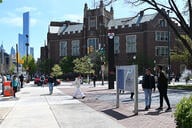You have /5 articles left.
Sign up for a free account or log in.
Before my first piece, allow me to introduce myself -- my name is Mary Ellen Giess and I’m a senior director at IFYC, where I’ve worked for over a decade. As a Unitarian Universalist, my religious values inspire a deep commitment to the inherent worth and dignity of every person as well as an embrace of all types of diversity (articulated in the UU seven principles). However, my experiences being raised UU highlighted the fact that while we may regularly articulate these values, my own communities (whether UU or otherwise) often fail to live up to our own goals around appreciation of deep difference. In other words, we aren’t as good about welcoming the “differences we don’t like,” in Eboo’s language. With Eboo’s invitation to contribute to this blog, I hope to explore the personal and societal tensions of embodying multiple and often competing values within the context of a religiously diverse democracy. Academically, my background is in religious studies and I have a specific interest in religion and constitutional law, which I explored at UNC Chapel Hill and Harvard Divinity School. My time at IFYC has afforded me many exciting opportunities, including working with the Obama White House on the President’s Interfaith and Community Service Challenge, collaborating with faculty researchers to develop and implement a five-year longitudinal research project on religious diversity in higher education (IDEALS), and working with higher education leaders across the country to advance interfaith engagement on college campuses. I’m a mother of three daughters and a resident of Charleston, S.C., and look forward to sharing my thoughts with you.
***
What, exactly, does a culture of free speech look like on campus? So much of the free speech debate is framed in terms of whose rights are being stifled or limited -- certainly understandable in the legal context, and in my view, there are many instances where college campuses have gone too far. At the same time, the predominant media narrative is one of a free speech “crisis” on campus, which overlooks the more important question. What does a culture look like where free speech and free exchange thrives?
The broader context of the “free speech crisis” narrative was very much on my mind when I was invited to attend a recent roundtable on free speech and free expression hosted by the Charles Koch Foundation. What, I wondered, would the tone of this conversation be?
Quite richer than the common “crisis” narrative, as it turns out. The convening brought together higher education faculty and other social sector leaders approaching free speech and free expression issues on campus from a variety of vantage points. One nonprofit leader explained how her work supporting projects conceived and led by college student journalists contributes to a vibrant discourse on campus. A faculty researcher discussed her ethnographic research on storytelling across the rural-urban divide and how that relationship building was contributing to a broader culture of free speech on her campus. Staff from Heterodox Academy shared a trend in their research showing that students often self-censor out of fear from how their peers may respond.
The breadth of the conversation prompted me to reflect on that larger question: What, exactly, does it look like to build a culture of free speech on campus? Some of IFYC’s own research from the Interfaith Diversity Experiences and Attitudes Longitudinal Study (IDEALS, conducted in partnership with Matt Mayhew from Ohio State and Alyssa Rockenbach from North Carolina State) sheds interesting light on this question. One of the key priorities of the IDEALS study is examining which educational practices and contextual realities affect student “pluralism orientation,” or commitment to bridging religious and worldview divides. Based on data examining the first-year experience, an interesting finding is that students who experience greater support for their own worldview on campus are more likely to have higher appreciation for specific identity differences and prioritize productively bridging worldview divides. In other words, feeling secure and supported in your own perspective is linked to appreciation of others and valuing engagement across difference.
What an interesting tension -- that the often denigrated “safe spaces” may in fact be an important key to productive engagement across lines of difference.
What if we applied these findings to the disputes around free speech? If we took the IDEALS findings seriously, it might indicate that the free speech controversies do not only revolve around infringement of individual rights -- these controversies may also signal that some communities are struggling to find productive support for their own identities, which in turn leads to discord around difference. In my mind, this finding suggests that a critical missing element of the conversation around free speech is widening our understanding of the problem: rather than focusing only on defending individual rights, we need to consider the ways that various communities need to be supported and engaged in order to foster an environment where productive engagement across difference becomes possible. A culture where free speech thrives, then, is one where all communities on campus feel supported and appreciated -- and therefore, better able to engage with openness.
Which leaves us with yet another interesting tension -- the combative approach that a handful of loud activist voices are utilizing to advance their perspectives, far from providing space and support for all communities on campus, sadly undermines the very vision of a diverse, inclusive society that they seek to promote.
How might this paradigm shift of prioritizing a culture of inclusion alongside individual freedom change the conversation about free speech on campus? Some data, at least, suggest it may be a more impactful way to go.

